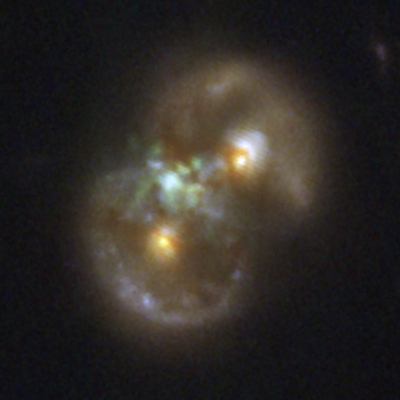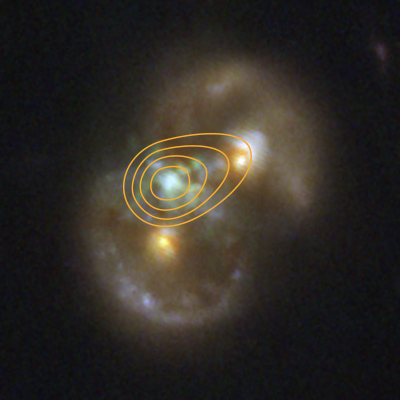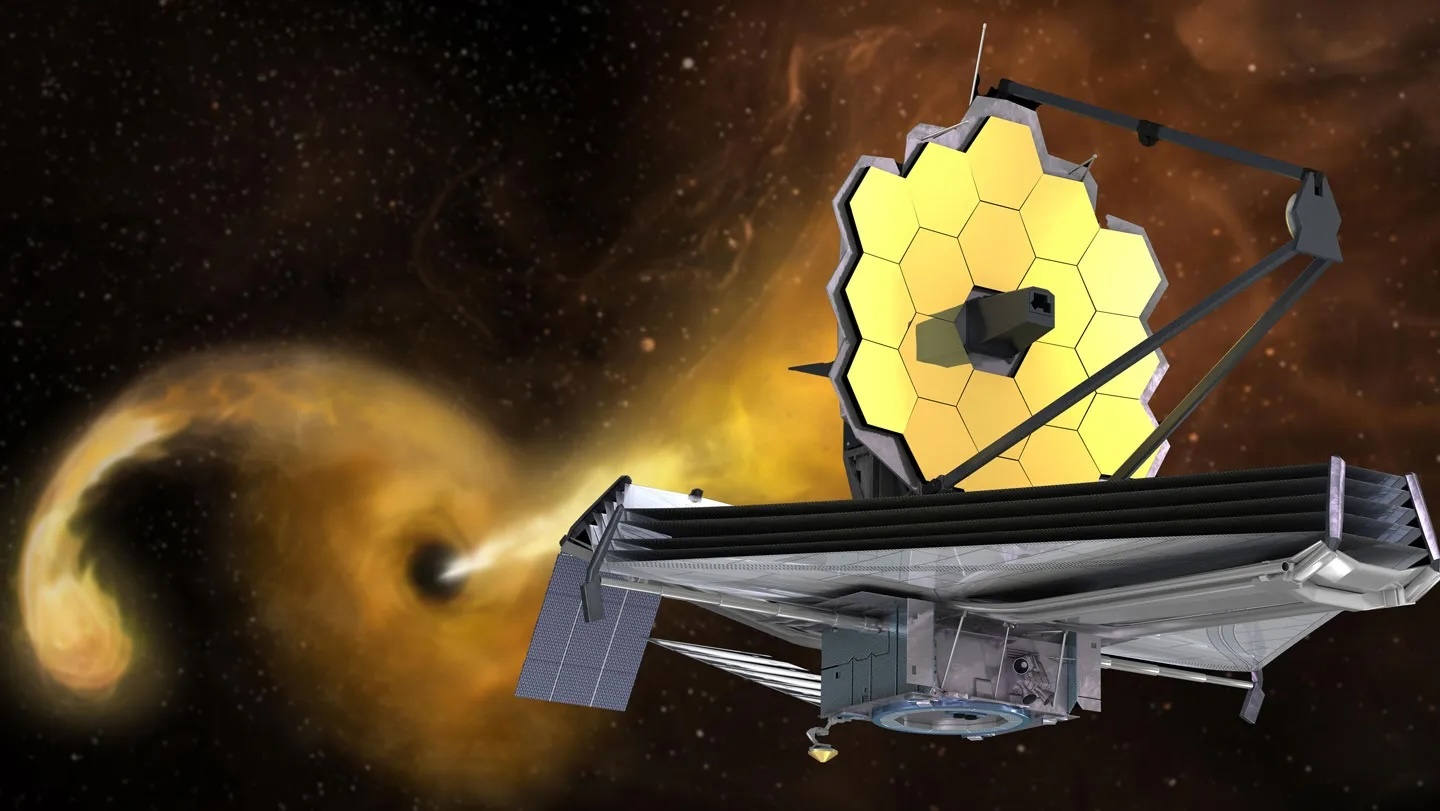“There are two other possibilities that come to mind. First, it could be a runaway black hole that got ejected from a galaxy and just happens to be passing through. Second, it could be a black hole at the center of a third galaxy in the same location on the sky. If it were in a third galaxy, we would expect to see the surrounding galaxy unless it were a faint dwarf galaxy. However, dwarf galaxies don’t tend to host giant black holes.
“If the black hole were a runaway, or if it were in an unrelated galaxy, we would expect it to have a very different velocity from the gas in the Infinity Galaxy. We realized that this would be our test – measure the velocity of the gas and the velocity of the black hole, and compare them. If the velocities are close, within maybe 30 miles per second (50 kilometers per second), then it becomes hard to argue that the black hole is not formed out of that gas.
“We applied for and received director’s discretionary time to follow up on this target with Webb, and our preliminary results are exciting. First, the presence of an extended distribution of ionized gas in between the two nuclei is confirmed. Second, the black hole is beautifully in the middle of the velocity distribution of this surrounding gas – as expected if it formed there. This is the key result that we were after!
“Third, as an unexpected bonus, it turns out that both galaxy nuclei also have an active supermassive black hole. So, this system has three confirmed active black holes: two very massive ones in both of the galaxy nuclei, and the one in between them that might have formed there.
“We can’t say definitively that we have found a direct collapse black hole. But we can say that these new data strengthen the case that we’re seeing a newborn black hole, while eliminating some of the competing explanations. We will continue to pore through the data and investigate these possibilities.”
"The biggest surprise of all was that the black hole was not located inside either of the two nuclei but in the middle. We asked ourselves: How can we make sense of this?"
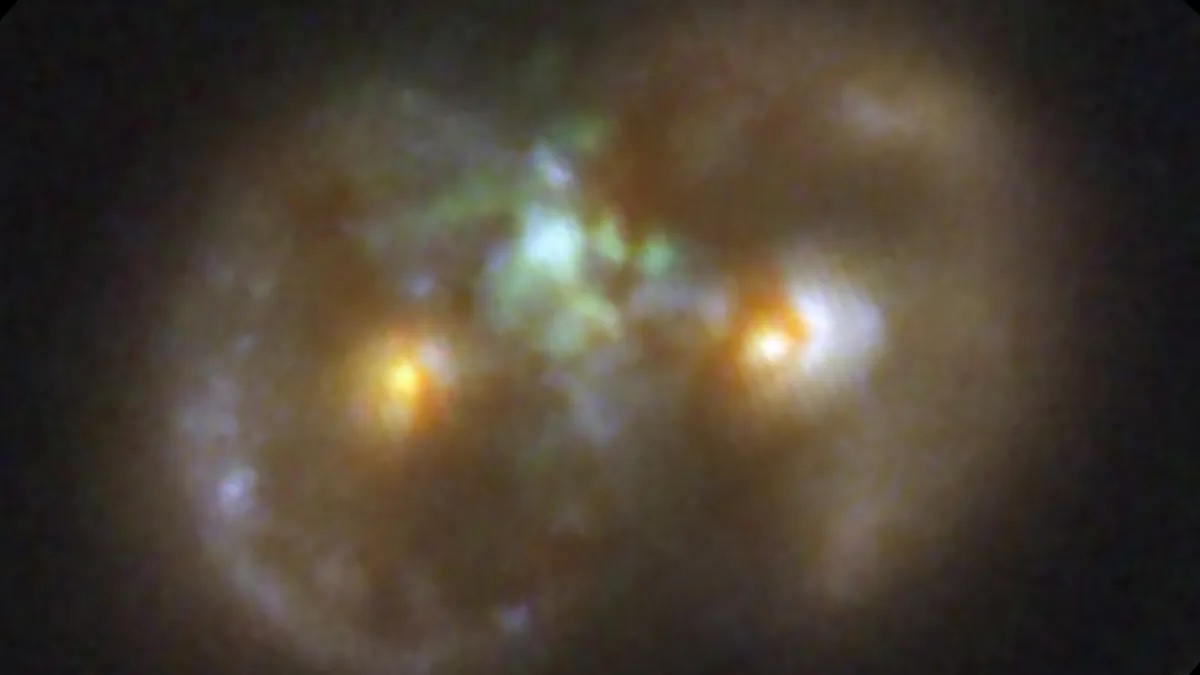
An image of the Infinity Galaxy as seen by the James Webb Space Telescope (Image credit: NASA, ESA, CSA, STScI, P. van Dokkum (Yale University).)
Using the James Webb Space Telescope (JWST), astronomers have discovered an oddball galaxy, dubbed the Infinity Galaxy, that could be host to a "direct collapse black hole." That is, a black hole originally created directly from a vast cloud of collapsing gas and dust rather than a dying star.
The Infinity Galaxy gets its name from the fact that its shape resembles an infinity symbol (a sideways 8) with two red lobes or "nuclei." This shape is thought to have arisen because the Infinity Galaxy was formed as two disk galaxies engaged in a head-on collision.
What makes this highly unusual is the fact that this black hole sits between the two colliding galaxies in a vast cloud of gas, rather than in either respective nucleus. From its perch between these galaxies, the black hole now feeds greedily on that gas, but researchers think that same cloud also once birthed it. That would make this the first observational evidence of the direct collapsepathway of black hole birth.
The researchers behind these findings uncovered the Infinity Galaxy while examining images from the JWST's 255-hour treasury COSMOS-Web survey. In addition to the suspected direct collapse black hole that sits between the colliding galaxies, the team found that each nucleus of those galaxies also contains a supermassive black hole!
"Everything is unusual about this galaxy. Not only does it look very strange, but it also has this supermassive black hole that's pulling a lot of material in," team leader and Yale University researcher Pieter van Dokkum said in a statement. "The biggest surprise of all was that the black hole was not located inside either of the two nuclei but in the middle.
"We asked ourselves: How can we make sense of this?"
van Dokkum explained that finding a black hole not in the nucleus of a massive galaxy isn't, in itself, unusual. What is strange is the question of how that black hole got there.
"It likely didn't just arrive there, but instead it formed there," van Dokkum said. "And pretty recently. In other words, we think we're witnessing the birth of a supermassive black hole – something that has never been seen before."
This discovery could solve an intriguing mystery regarding the observation of supermassive black holes with masses millions or billions of times that of the sun, less than 1 billion years after the Big Bang.
Black holes could skip stellar deaths and supernovas
Since it began operating three years ago, the JWST has delivered something of a conundrum to cosmologists; observations that show supermassive black holes seem common as early as 500 million years after the Big Bang.
That's a problem because it was previously proposed that supermassive black holes form through successive mergers of smaller black holes. However, beginning this process with so-called stellar-mass black holes would require waiting for the first generation of stars to form, live their lives, then collapse in supernova explosions. The resulting black holes would have to undergo a series of mergers and periods of intense feeding upon interstellar gas and dust.
This process would take at least a billion years to "grow" a black hole to supermassive status. Thus, seeing a multitude of supermassive black holes before the universe was 1 billion years old is problematic.
That is, unless these bodies got a head start by skipping the stellar life and birth stage of this process.
"How supermassive black holes formed is a long-standing question. There are two main theories, called 'light seeds' and 'heavy seeds.' In the light seed theory, you start with small black holes formed when a star's core collapses and the star explodes as a supernova," van Dokkum explained. "That might result in a black hole weighing up to about 1,000 suns. You form a lot of them in a small space, and they merge over time to become a much more massive black hole."
As mentioned above, the problem with that is the time this process would take and the JWST's discovery of incredibly massive black holes at early stages of our 13.8 billion-year-old universe.
Black holes could have heavy seeds
Alternatively, the heavy seed theory sees supermassive black hole growth kickstarted with a much larger black hole, maybe up to one million times the mass of the sun. This forms directly from the collapse of a large gas cloud.
"You immediately form a giant black hole, so it's much quicker. However, the problem with forming a black hole out of a gas cloud is that gas clouds like to form stars as they collapse rather than a black hole, so you have to find some way of preventing that. It's not clear that this direct-collapse process could work in practice," van Dokkum said. "By looking at the data from the Infinity Galaxy, we think we've pieced together a story of how this could have happened here."
The researchers suggest that as the two disk galaxies collided, a ring structure of stars, visible in the JWST image, was formed. During this collision, gas within these two galaxies would have been shocked and compressed. They think this compression may have been so extreme that it formed a "dense knot" in the gas, which then collapsed into a black hole.
As van Dokkum explained, there is a wealth of circumstantial evidence for this formation channel for the black hole in the Infinity Galaxy.
"We observe a large swath of ionized gas, specifically hydrogen that has been stripped of its electrons, that's right in the middle between the two nuclei, surrounding the supermassive black hole," he continued. "We also know that the black hole is actively growing – we see evidence of that in X-rays from NASA'sChandra X-ray Observatory and radio from the Very Large Array. Nevertheless, the question is, did it form there?"
There are two possible explanations that don't involve a direct collapse black hole forming at the intersection of these merged galaxies.
"First, it could be a runaway black hole that got ejected from a galaxy and just happens to be passing through," van Dokkum said. "Second, it could be a black hole at the center of a third galaxy in the same location on the sky. If it were in a third galaxy, we would expect to see the surrounding galaxy unless it were a faint dwarf galaxy. However, dwarf galaxies don't tend to host giant black holes.
"If the black hole were a runaway, or if it were in an unrelated galaxy, we would expect it to have a very different velocity from the gas in the Infinity Galaxy."
To test this, the team intends to measure the velocity of the gas and the velocity of the black hole and compare them. Should those velocities be close, within around 30 miles per second (50 kilometers per second), then van Dokkum asserts that it will be hard to argue that the black hole is not formed from that gas.
"Our preliminary results are exciting. First, the presence of an extended distribution of ionized gas between the two nuclei is confirmed. Second, the black hole is beautifully in the middle of the velocity distribution of this surrounding gas, as expected if it formed there. This is the key result that we were after!" van Dokkum continued. "Third, as an unexpected bonus, it turns out that both galaxy nuclei also have an active supermassive black hole."
Though the team can't say definitively that they discovered a direct collapse black hole, they can state with confidence that this JWST data strengthens the case for this being a newborn black hole, while eliminating some of the counter-explanations to the direct collapse pathway.
"This system has three confirmed active black holes: two very massive ones in both of the galaxy nuclei, and the one in between them that might have formed there," van Dokkum said. "We will continue to pore through the data and investigate these possibilities."
Quelle: SC
----
Update: 1.08.2025
.
NASA’s Webb Traces Details of Complex Planetary Nebula
Since their discovery in the late 1700s, astronomers have learned that planetary nebulae, or the expanding shell of glowing gas expelled by a low-intermediate mass star late in its life, can come in all shapes and sizes. Most planetary nebula present as circular, elliptical, or bi-polar, but some stray from the norm, as seen in new high-resolution images of planetary nebulae by NASA’s James Webb Space Telescope.
Webb’s newest look at planetary nebula NGC 6072 in the near- and mid-infrared shows what may appear as a very messy scene resembling splattered paint. However, the unusual, asymmetrical appearance hints at more complicated mechanisms underway, as the star central to the scene approaches the very final stages of its life and expels shells of material, losing up to 80 percent of its mass. Astronomers are using Webb to study planetary nebulae to learn more about the full life cycle of stars and how they impact their surrounding environments.
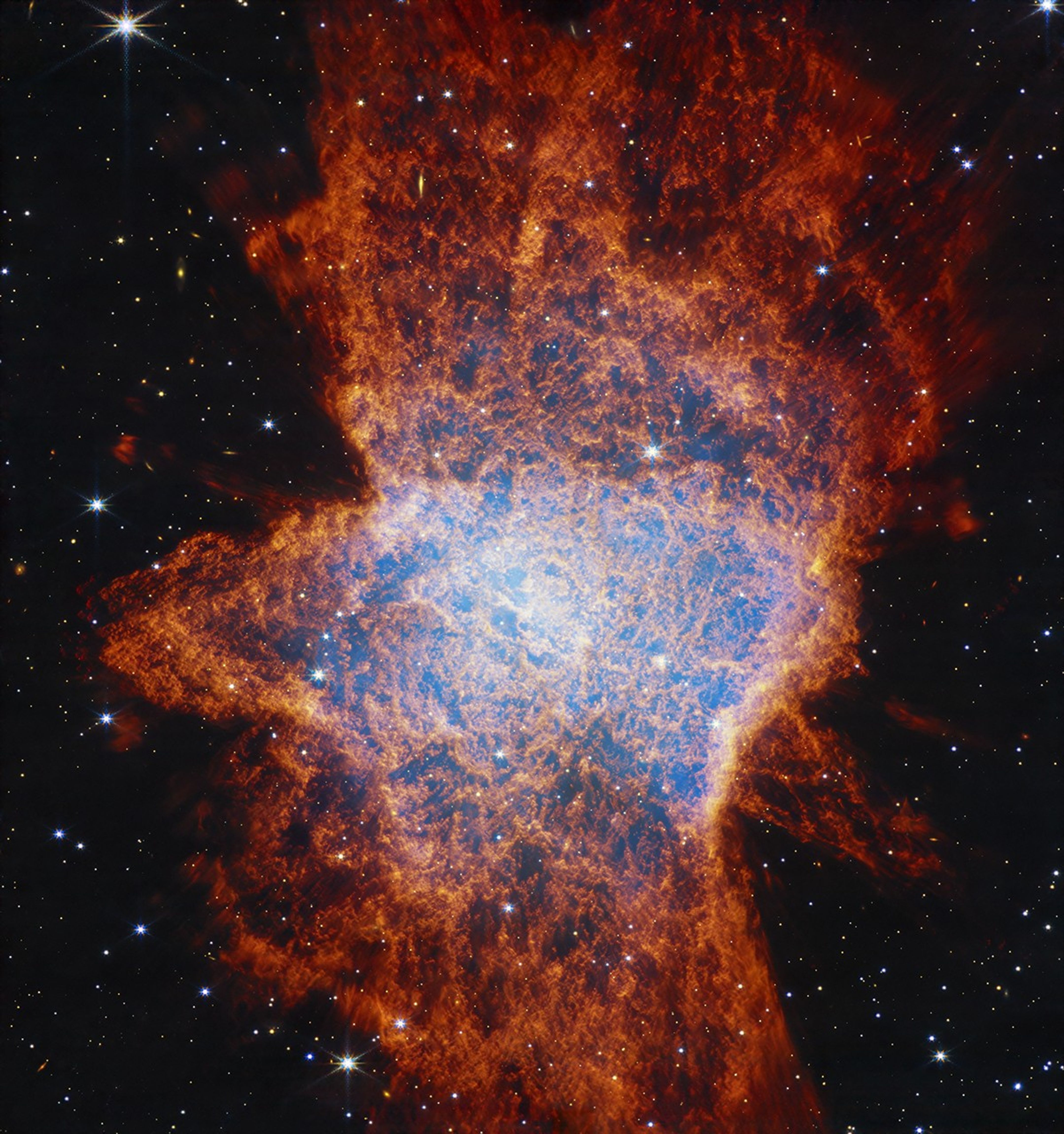
NASA’s James Webb Space Telescope’s view of planetary nebula NGC 6072 in the near-infrared shows a complex scene of multiple outflows expanding out at different angles from a dying star at the center of the scene. In this image, the red areas represent cool molecular gas, for example, molecular hydrogen.
NASA, ESA, CSA, STScI
First, taking a look at the image from Webb’s NIRCam (Near-Infrared Camera), it’s readily apparent that this nebula is multi-polar. This means there are several different elliptical outflows jetting out either way from the center, one from 11 o’clock to 5 o’clock, another from 1 o’clock to 7 o’clock, and possibly a third from 12 o’clock to 6 o’clock. The outflows may compress material as they go, resulting in a disk seen perpendicular to it.
Astronomers say this is evidence that there are likely at least two stars at the center of this scene. Specifically, a companion star is interacting with an aging star that had already begun to shed some of its outer layers of gas and dust.
The central region of the planetary nebula glows from the hot stellar core, seen as a light blue hue in near-infrared light. The dark orange material, which is made up of gas and dust, follows pockets or open areas that appear dark blue. This clumpiness could be created when dense molecular clouds formed while being shielded from hot radiation from the central star. There could also be a time element at play. Over thousands of years, inner fast winds could be ploughing through the halo cast off from the main star when it first started to lose mass.
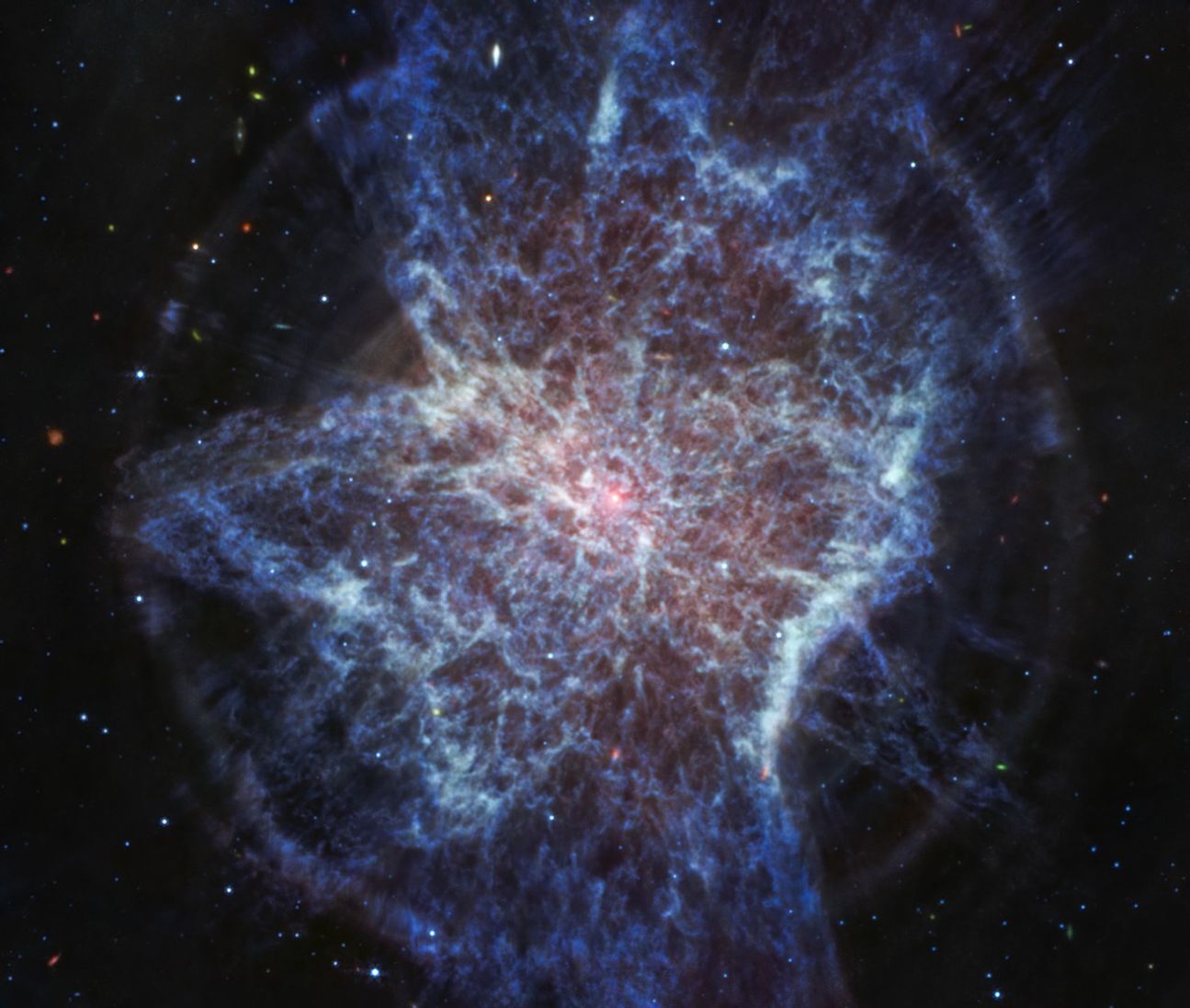
The mid-infrared view of planetary nebula NGC 6072 from NASA’s James Webb Space Telescope show expanding circular shells around the outflows from the dying central star. In this image, the blue represents cool molecular gas seen in red in the image from Webb’s NIRCam (Near-Infrared Camera) due to color mapping.
NASA, ESA, CSA, STScI
The longer wavelengths captured by Webb’s MIRI (Mid-Infrared Instrument) are highlighting dust, revealing the star researchers suspect could be central to this scene. It appears as a small pinkish-whitish dot in this image.
Webb’s look in the mid-infrared wavelengths also reveals concentric rings expanding from the central region, the most obvious circling just past the edges of the lobes.
This may be additional evidence of a secondary star at the center of the scene hidden from our view. The secondary star, as it circles repeatedly around the original star, could have carved out rings of material in a bullseye pattern as the main star was expelling mass during an earlier stage of its life.
The rings may also hint at some kind of pulsation that resulted in gas or dust being expelled uniformly in all directions separated by say, thousands of years.
The red areas in NIRCam and blue areas in MIRI both trace cool molecular gas (likely molecular hydrogen) while central regions trace hot ionized gas.
As the star at the center of a planetary nebula cools and fades, the nebula will gradually dissipate into the interstellar medium — contributing enriched material that helps form new stars and planetary systems, now containing those heavier elements.
Webb’s imaging of NGC 6072 opens the door to studying how the planetary nebulae with more complex shapes contribute to this process.
The James Webb Space Telescope is the world’s premier space science observatory. Webb is solving mysteries in our solar system, looking beyond to distant worlds around other stars, and probing the mysterious structures and origins of our universe and our place in it. Webb is an international program led by NASA with its partners, ESA (European Space Agency) and CSA (Canadian Space Agency).
Quelle: NASA
----
Update: 3.08.2025
.
The James Webb Space Telescope took its first look at black holes shredding and feasting on stars (illustration shown).
NRAO/AUI/NSF, NASA
The James Webb Space Telescope has taken its first look at black holes secretly snacking on stars within dusty galaxies. JWST’s ability to pick up detailed infrared signals lets it peer past the dust to probe the mostly hidden black holes, researchers report in the Aug. 1 Astrophysical Journal Letters.
A dormant black hole is normally impossible to see. That changes when a star wanders too close. The black hole’s gravity stretches the star into a disk that rotates around and feeds the temporarily awakened giant in a tidal disruption event, or TDE. The disk of star gas heats up and emits X-rays and ultraviolet and visible light, which is how astronomers typically find sleepy black holes.
But “these wavelengths can be basically blocked” if dust shrouds a feasting black hole, says MIT astrophysicist Megan Masterson. Most known TDEs took place in fairly clear environments, but the events probably happen just as often in dusty, obscured galaxies, she and her colleagues recently reported. They’re just harder to see.
That dust, however, gives off its own signals. It releases infrared light after absorbing the gas’s emissions in other wavelengths. In previous work, Masterson and colleagues searched archived data from an infrared-based space survey and spotted 12 probable TDEs.
Masterson and colleagues set JWST’s sights on four of those TDEs. JWST, which sees in a wider range of infrared wavelengths than previous telescopes, detected infrared emissions from atoms that had been stripped of electrons through strong X-ray and ultraviolet radiation. That’s a telltale sign of a dining black hole.
Bright gas disks around fully awake black holes, which feed constantly and are surrounded by dust clumps, could give off similar radiation. But the observed signs of silicate dust looked more like specks swirling around a dormant black hole briefly waking up for a stellar snack, the team found. Computer simulations confirmed that TDEs could explain what JWST saw.
Infrared light emissions are delayed by a few months compared with the typically detected wavelengths because it takes time for the shredded star’s light to reach the dust. But they’re essentially the only way to study feasting black holes blanketed by dust, Masterson says.
Quelle: ScienceNews
----
Update: 9.08.2025
.
NASA’s Webb May Have Found A Planet Around The Closest Sun-Like Star
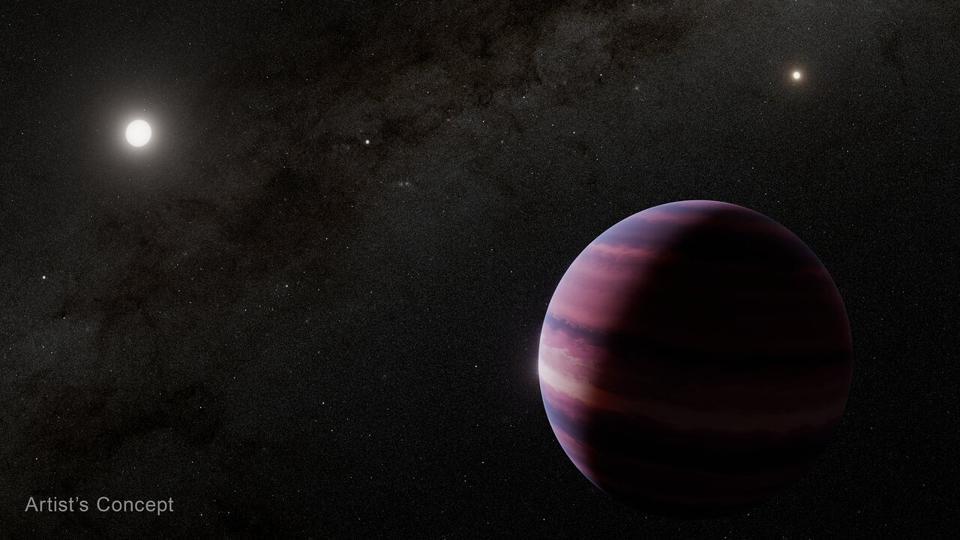
This artist’s concept shows what the gas giant orbiting Alpha Centauri A could look like.
NASA, ESA, CSA, STSCI, R. HURT (
NASA has announced the probable discovery of a giant planet orbiting Alpha Centauri A, one of the closest stars to the solar system. If confirmed, it would be the nearest planet ever detected around a sun-like star. Although it’s in the habitable zone of the star, it’s a gas giant, so it would not support life as we know it.
Astronomers using the James Webb Space Telescope found a planet while observing Alpha Centauri, a system of three stars orbiting each other — binary stars Alpha Centauri A and B, along with the red dwarf star Proxima Centauri. They’re just four light-years from the solar system.
Breakthrough Discovery
It’s been known for some time that three planets are orbiting Proxima Centauri, but planets around Alpha Centauri A — a star much like the sun — have until now proved elusive.
The breakthrough came when astronomers used a coronagraph — a disk to block the bright starlight — from Alpha Centauri A, revealing a faint object around it. Around 10,000 times dimmer than the star, the planet is about twice as far from its star as Earth is from the sun. The evidence was published across two papers in The Astrophysical Journal Letters.
Possible Saturn-Mass World
Based on brightness and simulations, researchers believe the object could be a gas giant about the mass of Saturn — though additional observations will be needed to confirm the planet’s existence. The discovery at Alpha Centauri A — the third brightest star in the night sky — could be a massive breakthrough for planetary scientists wanting to learn more about exoplanets (planets orbiting stars other than the sun).
“With this system being so close to us, any exoplanets found would offer our best opportunity to collect data on planetary systems other than our own,” said Charles Beichman, NASA’s Jet Propulsion Laboratory and the NASA Exoplanet Science Institute at Caltech’s IPAC astronomy center, co-first author on the new papers. “Yet, these are incredibly challenging observations to make, even with the world’s most powerful space telescope, because these stars are so bright, close, and move across the sky quickly.”
Disappearing Planet?
However, it’s not entirely clear that this planet exists at all. First sighted in 2019 by the European Southern Observatory’s Very Large Telescope, astronomers spotted it in August 2024, using the coronagraph in Webb’s MIRI instrument. However, light from Alpha Centauri B made it a difficult observation. Attempts to confirm the planet’s existence in February 2025 and April 2025 did not succeed.
Researchers were not surprised, having modelled where the planet ought to be on its elliptical orbit. “We found that in half of the possible orbits simulated, the planet moved too close to the star and wouldn’t have been visible to Webb in both February and April 2025,” said Ph.D. student Aniket Sanghi of Caltech in Pasadena, California, the co-first author on the two papers covering the team’s research. “Its very existence in a system of two closely separated stars would challenge our understanding of how planets form, survive, and evolve in chaotic environments.”
It’s hoped that NASA’s Nancy Grace Roman Space Telescope, set to launch as soon as 2026, could complement Webb’s infrared data with visible-light observations, helping confirm the planet and figure out its size and composition. Either way, Alpha Centauri A’s gas giant will be a prime target for the next generation of astronomers and telescopes.
Quelle: Forbes
----
Update: 15.08.2025
.
Webb Narrows Atmospheric Possibilities for Earth-sized Exoplanet TRAPPIST-1 d
The exoplanet TRAPPIST-1 d intrigues astronomers looking for possibly habitable worlds beyond our solar system because it is similar in size to Earth, rocky, and resides in an area around its star where liquid water on its surface is theoretically possible. But according to a new study using data from NASA’s James Webb Space Telescope, it does not have an Earth-like atmosphere.
“Ultimately, we want to know if something like the environment we enjoy on Earth can exist elsewhere, and under what conditions. While NASA’s James Webb Space Telescope is giving us the ability to explore this question in Earth-sized planets for the first time, at this point we can rule out TRAPPIST-1 d from a list of potential Earth twins or cousins,” said Caroline Piaulet-Ghorayeb of the University of Chicago and Trottier Institute for Research on Exoplanets (IREx) at Université de Montréal, lead author of the study published in The Astrophysical Journal.
The TRAPPIST-1 system is located 40 light-years away and was revealed as the record-holder for most Earth-sized rocky planets around a single star in 2017, thanks to data from NASA’s retired Spitzer Space Telescope and other observatories. Due to that star being a dim, relatively cold red dwarf, the “habitable zone” or “Goldilocks zone” – where the planet’s temperature may be just right, such that liquid surface water is possible – lies much closer to the star than in our solar system. TRAPPIST-1 d, the third planet from the red dwarf star, lies on the cusp of that temperate zone, yet its distance to its star is only 2 percent of Earth’s distance from the Sun. TRAPPIST-1 d completes an entire orbit around its star, its year, in only four Earth days.
Webb’s NIRSpec (Near-Infrared Spectrograph) instrument did not detect molecules from TRAPPIST-1 d that are common in Earth’s atmosphere, like water, methane, or carbon dioxide. However, Piaulet-Ghorayeb outlined several possibilities for the exoplanet that remain open for follow-up study.
“There are a few potential reasons why we don’t detect an atmosphere around TRAPPIST-1 d. It could have an extremely thin atmosphere that is difficult to detect, somewhat like Mars. Alternatively, it could have very thick, high-altitude clouds that are blocking our detection of specific atmospheric signatures — something more like Venus. Or, it could be a barren rock, with no atmosphere at all,” Piaulet-Ghorayeb said.
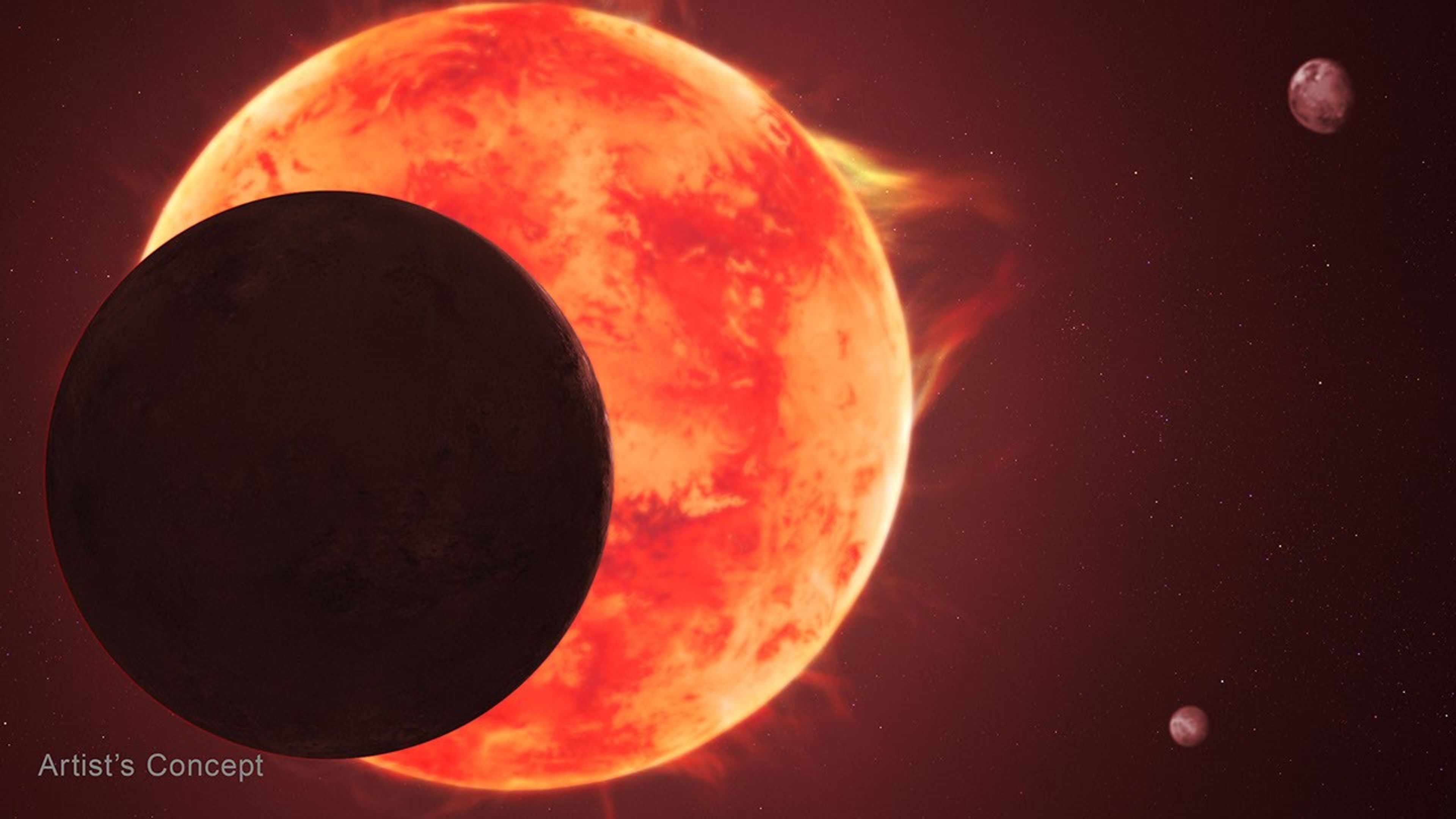
This artist’s concept depicts planet TRAPPIST-1 d passing in front of its turbulent star, with other members of the closely packed system shown in the background. The TRAPPIST-1 system is intriguing to scientists for a few reasons. Not only does the system have seven Earth-sized rocky worlds, but its star is a red dwarf, the most common type of star in the Milky Way galaxy. If an Earth-sized world can maintain an atmosphere here, and thus have the potential for liquid surface water, the chance of finding similar worlds throughout the galaxy is much higher. In studying the TRAPPIST-1 planets, scientists are determining the best methods for separating starlight from potential atmospheric signatures in data from NASA’s James Webb Space Telescope. The star TRAPPIST-1’s variability, with frequent flares, provides a challenging testing ground for these methods.
NASA, ESA, CSA, Joseph Olmsted (STScI)
No matter what the case may be for TRAPPIST-1 d, it’s tough being a planet in orbit around a red dwarf star. TRAPPIST-1, the host star of the system, is known to be volatile, often releasing flares of high-energy radiation with the potential to strip off the atmospheres of its small planets, especially those orbiting most closely. Nevertheless, scientists are motivated to seek signs of atmospheres on the TRAPPIST-1 planets because red dwarf stars are the most common stars in our galaxy. If planets can hold on to an atmosphere here, under waves of harsh stellar radiation, they could, as the saying goes, make it anywhere.
“Webb’s sensitive infrared instruments are allowing us to delve into the atmospheres of these smaller, colder planets for the first time,” said Björn Benneke of IREx at Université de Montréal, a co-author of the study. “We’re really just getting started using Webb to look for atmospheres on Earth-sized planets, and to define the line between planets that can hold onto an atmosphere, and those that cannot.”
Webb observations of the outer TRAPPIST-1 planets are ongoing, which hold both potential and peril. On the one hand, Benneke said, planets e, f, g, and h may have better chances of having atmospheres because they are further away from the energetic eruptions of their host star. However, their distance and colder environment will make atmospheric signatures more difficult to detect, even with Webb’s infrared instruments.
“All hope is not lost for atmospheres around the TRAPPIST-1 planets,” Piaulet-Ghorayeb said. “While we didn’t find a big, bold atmospheric signature at planet d, there is still potential for the outer planets to be holding onto a lot of water and other atmospheric components.”
“As NASA leads the way in searching for life outside our solar system, one of the most important avenues we can pursue is understanding which planets retain their atmospheres, and why,” said Shawn Domagal-Goldman, acting director of the Astrophysics Division at NASA Headquarters in Washington. “NASA’s James Webb Space Telescope has pushed our capabilities for studying exoplanet atmospheres further than ever before, beyond extreme worlds to some rocky planets – allowing us to begin confirming theories about the kind of planets that may be potentially habitable. This important groundwork will position our next missions, like NASA’s Habitable Worlds Observatory, to answer a universal question: Are we alone?”
The James Webb Space Telescope is the world’s premier space science observatory. Webb is solving mysteries in our solar system, looking beyond to distant worlds around other stars, and probing the mysterious structures and origins of our universe and our place in it. Webb is an international program led by NASA with its partners, ESA (European Space Agency) and CSA (Canadian Space Agency).
Quelle: NASA
----
Update: 16.08.2025
.
James Webb Space Telescope uncovers 300 mysteriously luminous objects. Are they galaxies or something else?
The discovery could challenge current ideas about how galaxies formed in the early universe.
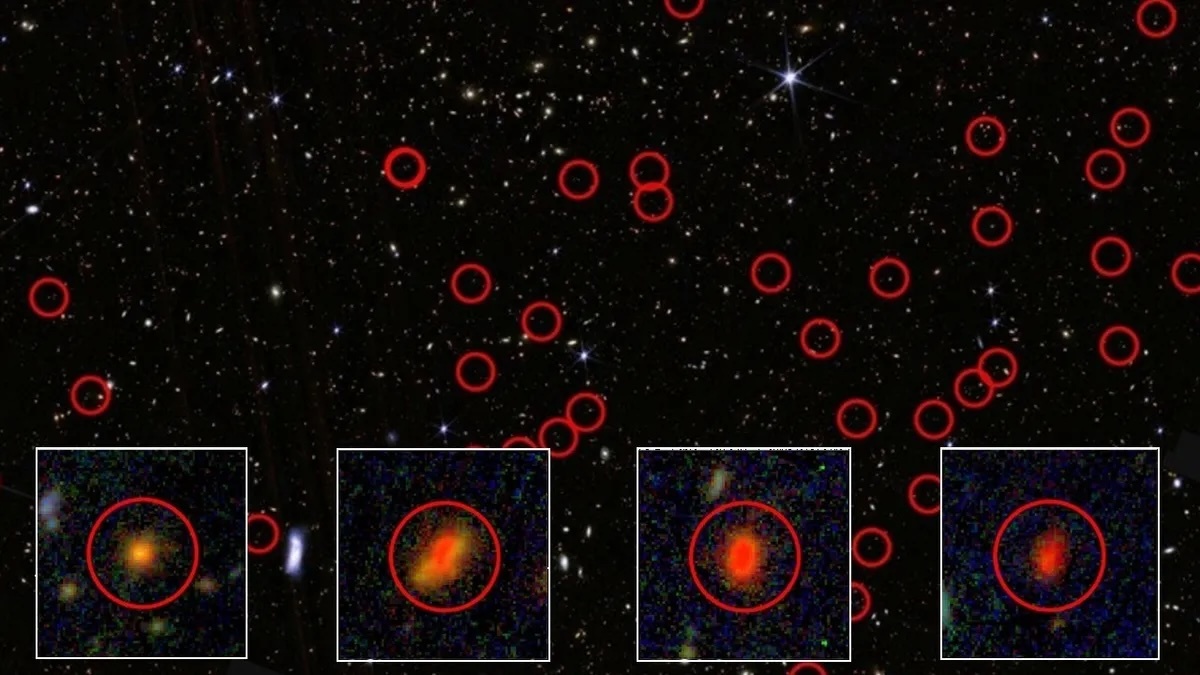
Hundreds of unusually bright early galaxy candidates have been identified in deep-field images from NASA's James Webb Space Telescope. (Image credit: Bangzheng "Tom" Sun)
Hundreds of unexpectedly energetic objects have been discovered throughout the distant universe, possibly hinting that the cosmos was far more active during its infancy than astronomers once believed.
Using deep-field images from NASA's James Webb Space Telescope (JWST), researchers at the University of Missouri identified 300 unusually bright objects in the early universe. While they could be galaxies, astronomers aren't yet sure what they are for certain. Galaxies forming so soon after the Big Bang should be faint, limited by the pace at which they could form stars. Yet these candidates shine far brighter than current models of early galaxy formation predict.
"If even a few of these objects turn out to be what we think they are, our discovery could challenge current ideas about how galaxies formed in the early universe — the period when the first stars and galaxies began to take shape," Haojing Yan, co-author of the study, said in a statement from the university.
To discover these objects, the team applied a method called the "dropout" technique, which detects objects that appear in redder wavelengths but vanish in bluer, shorter-wavelength images. This indicates the objects are extremely distant, showing the universe as it was more than 13 billion years ago.
To estimate distances, the team analyzed the objects' brightnesses across multiple wavelengths to infer redshift, age and mass. JWST's powerful Near-Infrared Camera and Mid-Infrared Instrument are designed to detect light from the farthest reaches of space, making them ideal for studying the early universe.
"As the light from these early galaxies travels through space, it stretches into longer wavelengths — shifting from visible light into infrared," Yan said in the statement. "This stretching, called redshift, helps us determine how far away these galaxies are. The higher the redshift, the closer the galaxy is to the beginning of the universe."
Next, the researchers hope to use targeted spectroscopic observations, focusing on the brightest sources. Confirming the newly found objects as genuine early galaxies would refine our current understanding of how quickly the first cosmic structures formed and evolved — and add to the growing list of transformative discoveries made by the JWST since it began observing the cosmos in 2022.
The findings were published June 27 in The Astrophysical Journal.
Quelle: SC
